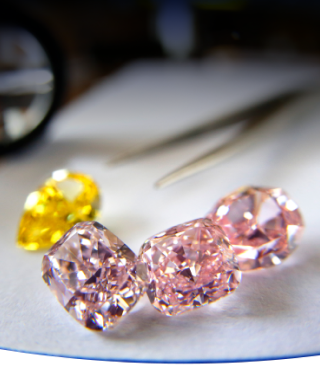Whether you are a diamond dealer or a sales person in a jewelry store, the 4C’s system is the first and only methodology used for classifying colorless diamonds. Efficient and easy to employ, each category in the system has its own hierarchy. Once its basic principles are understood, anyone can evaluate a colorless diamond accompanied with a report.
Because the end consumer cannot distinguish between two similar colorless diamonds that have different grades and values, they must rely on a source of authority to validate the quality of the stone prior to making a purchase. As the GIA is considered to be the ‘supreme court’ of diamond grading, we submissively accept any verdict given by this lab.
Our thinking process is, “…If the GIA report says this stone has the highest color, clarity and cut, it must be the best diamond money can buy, I’ll take it!”
When a fancy color diamond comes into the equation, it becomes more complicated because we realize there is no correlation between a good report and a good looking stone, or vice versa. Sales people understandably use the 4C’s terminology they know so well from the colorless world, like clarity, polish, symmetry and others, but this vocabulary is not relevant and does not properly describe a fancy color gem. This fact alone prevents us from carrying out a successful and intelligent sales pitch. From a bystander’s point of view, basing a stone’s value solely on its GIA report is like counting the notes of a symphony instead of listening to the music.
The Fancy Color Tool Box
Aside from carat weight, the fancy color ‘tool box’ is comprised of elements that rely on visual features which reduce the importance of non-visual features stated on the report, such as clarity, polish symmetry, depth, etc.
To appreciate the quality of a fancy color diamond, we need to identify three core elements:
The first element to consider is the inner-grade, which is how well a color’s intensity corresponds to our expectations from the GIA’s description; the second is color dispersion, or how evenly the color is distributed on the face up view of the diamond; and the third is undertone, which is our interpretation of subtle nuances in color.
These three elements are not expressed in any report, but have a huge commercial impact.
Although the complete fancy color tool box includes many other elements, the inner grade, color dispersion and undertone are the primary tools needed to begin a comprehensive sales presentation.
It is important to understand that a GIA report is a sufficient starting point for a conversation, but one must shift to a more robust and definitive vocabulary to describe a fancy color diamond during a sales process.
The FCRF’s goal is to further develop this vocabulary and continue enriching the fancy color ‘tool box’ with new, cutting edge data. As the saying goes, ‘information is power’.


